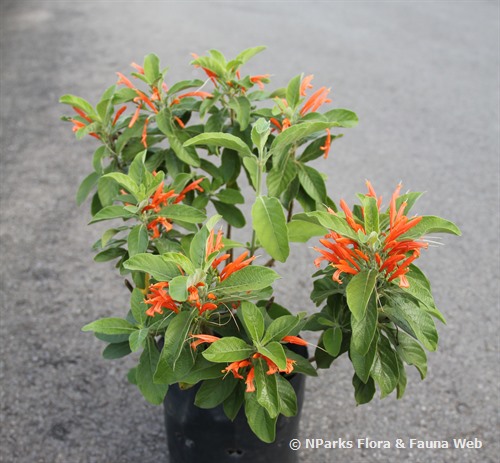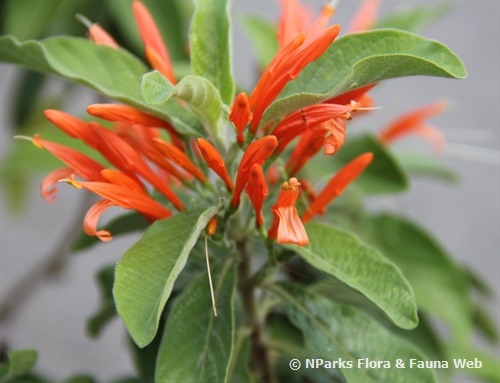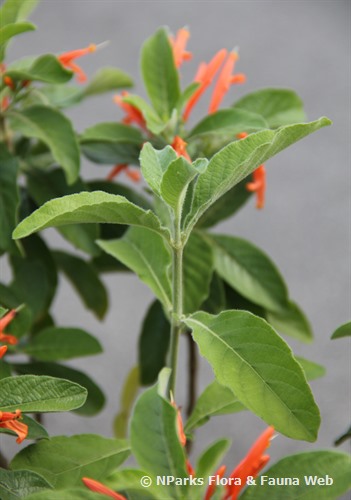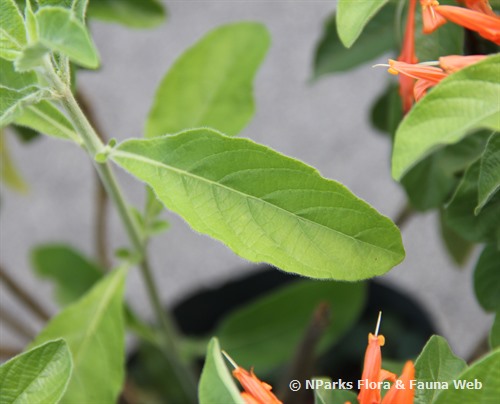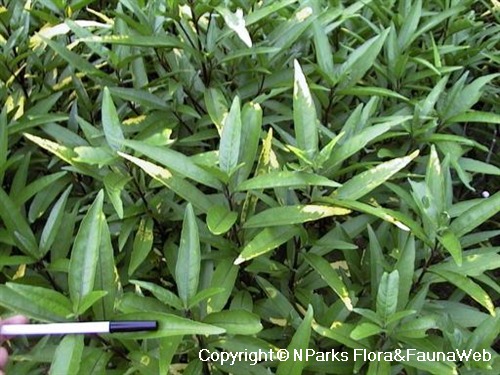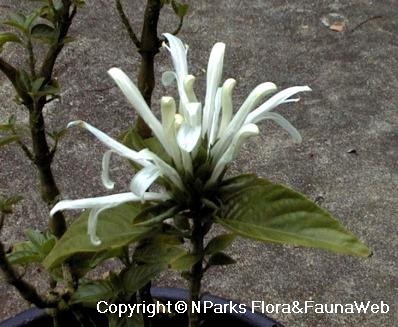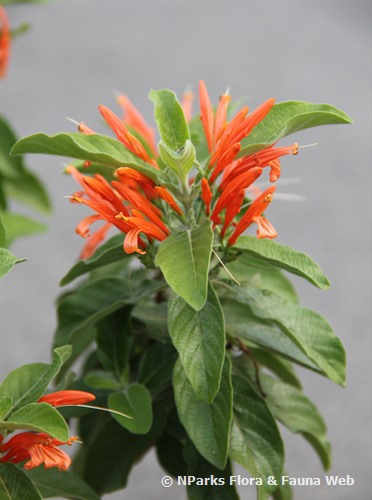
Back
Justicia spicigera
| Family Name: | Acanthaceae |
| Common Name: | Mexican Honeysuckle, Orange Plume Flower |
Name
Classifications and Characteristics
| Plant Division | Angiosperms (Flowering Seed Plants) (Dicotyledon) |
|---|---|
| Plant Growth Form | Shrub |
| Lifespan (in Singapore) | Perennial |
| Mode of Nutrition | Autotrophic |
| Plant Shape | Shrubby |
Biogeography
| Native Distribution | Mexico, Central and South America. |
|---|---|
| Native Habitat | Terrestrial |
| Preferred Climate Zone | Tropical |
| Local Conservation Status | Non-native |
Description and Ethnobotany
| Growth Form | An evergreen, densely branched shrub growing up to 1.5 m tall. |
|---|---|
| Foliage | Leaves are bright green, ovate shaped and has a slight fuzzy texture on the surface. Leaves are arranged oppositely along the stem. |
| Flowers | Flowers tubular or trumpet-shaped, orange in colour, measuring about 4 cm long. Clusters of flowers are found at the terminal of stem. |
| Fruit | Fruits are inconspicuous, not seen in cultivation. |
| Habitat | Found in disturbed vegetation area, tropical, deciduous and semi-deciduous, and evergreen forests. It is also found in desert, and mixed woodlands. |
| Cultivation | Grow plants in well-drained soil. Do not overwater as it will inhibit flowering, water moderately. Plant is tolerant to slight drought. |
| Etymology | The genus Justicia is named after James Justice, a Scottish horticulturist. The specific epithet spicigera means having inflorescence arranged in the form of spikes. |
| Ethnobotanical Uses | Agriculture - Forestry: It is used in Mexican traditional medicine to control cattle and sheep diseases such as parasitic infection. Others: In Mexico, Guatemala and some areas of United States of America, this plant is used as dye for crafts, paintings, and as traditional medicine. The leaves are used to produce a blue to red dye, to decorate baskets. |
Landscaping Features
| Landscaping | The striking orange tubular flowers, together with attractive bright green foliage add a tropical look to the landscape. It can be used as an accent shrub, planted together as informal hedge or grown as ground cover in large scale. |
|---|---|
| Desirable Plant Features | Ornamental Flowers |
| Landscape Uses | Parks & Gardens, Small Gardens, Flowerbed / Border, Container Planting |
Fauna, Pollination and Dispersal
| Fauna Pollination Dispersal Associated Fauna | Bird-Attracting (Flowers), Butterfly-Attracting (Flower Nectar) |
|---|
Plant Care and Propagation
| Light Preference | Full Sun, Semi-Shade |
|---|---|
| Water Preference | Moderate Water, Little Water |
| Rootzone Tolerance | Well-Drained Soils, Fertile Loamy Soils |
| Propagation Method | Stem Cutting |
Foliar
| Foliage Retention | Evergreen |
|---|---|
| Mature Foliage Colour(s) | Green |
| Mature Foliage Texture(s) | Smooth |
| Prominent Young Flush Colour(s) | Green |
| Young Flush Texture(s) | Smooth |
| Foliar Type | Simple / Unifoliate |
| Foliar Arrangement Along Stem | Opposite |
| Foliar Attachment to Stem | Petiolate |
| Foliar Shape(s) | Non-Palm Foliage |
| Foliar Venation | Pinnate / Net |
| Foliar Margin | Entire - Wavy / Undulate |
Floral (Angiosperm)
| Flower & Plant Sexuality | Bisexual Flowers |
| Flower Colour(s) | Orange |
|---|---|
| Flower Texture(s) | Smooth |
| Flower Grouping | Cluster / Inflorescence |
| Flower Location | Terminal |
| Flower Symmetry | Bilateral |
| Individual Flower Shape | Trumpet-shaped, Tubular |
| Inflorescence Type | Spike |
| Flowering Period | Free-Flowering |
Image Repository
Others
| Master ID | 33090 |
|---|---|
| Species ID | 7504 |
| Flora Disclaimer | The information in this website has been compiled from reliable sources, such as reference works on medicinal plants. It is not a substitute for medical advice or treatment and NParks does not purport to provide any medical advice. Readers should always consult his/her physician before using or consuming a plant for medicinal purposes. |

